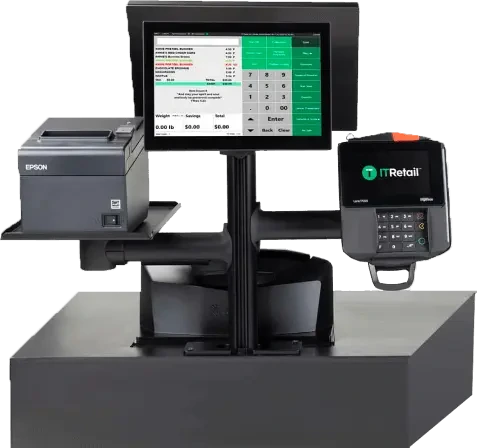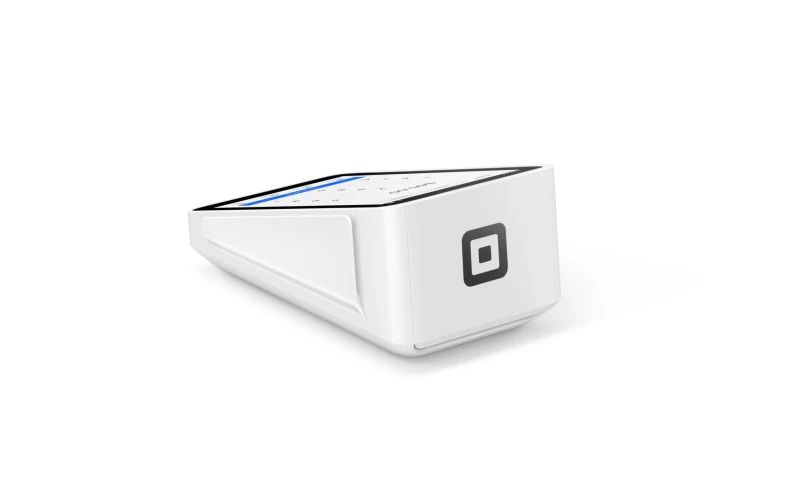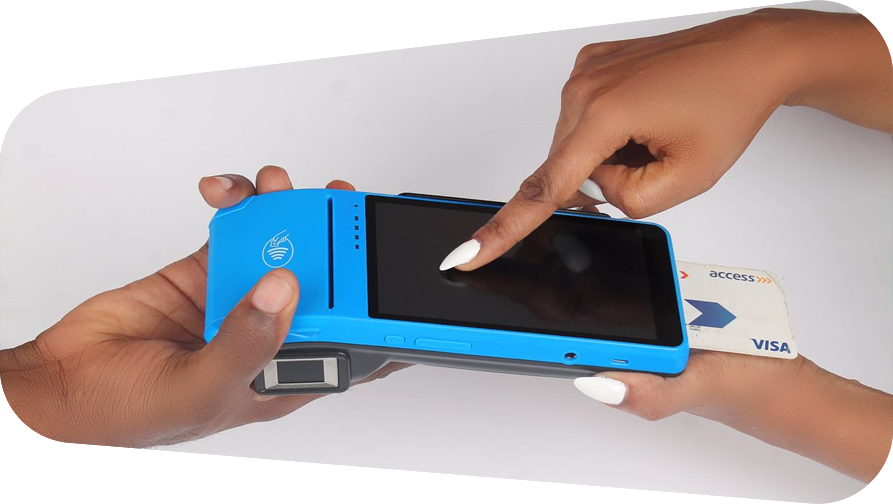Key takeaways
A point-of-sale (POS) terminal is a hardware component that processes card payment transactions. Most modern POS terminals can process credit, debit, and gift card payments via swipe, dip, or tap, and process digital wallet payments from smart devices. The location and functionality of your point-of- sale terminal varies by your industry and your POS hardware.
In this article…
Types of POS terminals
POS terminals may be freestanding payment reading devices or built into a POS display. This difference can lead to some confusion about what a POS terminal actually is. Think about a grocery store checkout lane. In most cases, the POS terminal is a pin-pad-enabled tap, dip, and swipe card reader that faces the customer. With this type of POS station configuration, it is obvious which component is the POS terminal.

Grocery stores and retail businesses tend to have dedicated checkout lanes with plenty of room for POS components. Restaurants, coffee shops, and other businesses with limited space typically prefer an all-in-one POS station with the POS terminal built into the POS display. In those businesses, the term “POS terminal” can appear to refer to the entire POS station.

POS terminal features
POS terminals’ only major task is to process card and digital payments. As payment technology evolves, POS terminals need to process traditional swipe payments along with handling new payment technologies as they appear.
A POS terminal must handle all these types of payments:
Magstripe
Commonly known as “swipe” payments, magstripe payments work by scanning a magnetic strip on the back of a credit, debit, or gift card. Even with the growth of new payment technologies, most payment cards are still equipped with magstripe. Magstripes have been around for decades, which makes them both reliable and prone to payment fraud; fraudsters have had many years to design ways to read the information from magstripe cards.
And while magstripe readers on POS terminals may be the least secure way to process payments, they will likely be around for many years to come. Physical gift cards are unlikely to shift to a different method of recording payment information, and magstripes are inexpensive and reliable.
Chip
Embedded Europay, Mastercard and Visa (EMV) chips in credit and debit cards are much more secure than magstripes. EMV chips are harder to counterfeit and less likely to be a source of fraudulent in-person payments. Most POS terminal EMV chip readers can process a chip card payment without the card leaving customers’ hands. Businesses that rely on EMV chip card payments typically see lower processing fees and fewer incidents of chargeback fees for fraudulent or contested transactions.
Contactless
Near field communication (NFC) or contactless payments, process payments from NFC-enabled cards and digital wallets on smart devices like phones or watches. As with EMV payments, NFC payments allow customers to pay without their payment method leaving their hand. It is also harder for potential fraudsters to strip card information from NFC payments than magstripe cards.
Some POS terminals offer additional features beyond payment processing. Most of these features require a terminal equipped with a customer-facing display or touch screen.
Transaction Display
Many modern POS terminals contain a screen that displays an itemized receipt for the customer. This ensures customers understand the full payment amount before paying. This can prevent unnecessary chargeback disputes by providing customers the opportunity to verify payment amounts.
Email Collection
If your POS terminal has a customer-facing touch-screen display, you can typically use it to collect customer emails to use for marketing purposes or merely to send digital receipts and save on paper costs.
Loyalty Enrollment
A touch-screen-enabled POS terminal can also typically be used to prompt customers to enroll in your loyalty program. With some POS systems, your terminal can also be used to process loyalty points as a payment method and show customers their loyalty points balance.
Looking for the latest in POS solutions? Check out our Retail POS Solutions Buyer’s Guide.
How to choose a point-of-sale terminal
The best POS terminal for your business will depend on your business type and where you need to process payments. If you are in the market for a POS terminal, there are a few questions to ask yourself to ensure you make the best decision.
Who is your POS provider?
Your POS terminal options will be limited by which POS provider you choose. Some POS providers integrate with multiple payment processors, which typically expands your options for POS terminals. Increasingly, though, POS providers package their POS systems with built-in payment processing. So if you have specific POS terminal needs, be sure to consider each POS provider’s hardware options before signing a long-term contract.
Where do you process payments?
Your POS terminal needs will vary if you process payments at a central cash wrap, multiple checkout lanes, or remote locations like swap meets or private events. If you process payments in a brick-and-mortar location, a traditional POS terminal with multiple card readers and a customer-facing touch screen will likely be your best bet. If you need to accept payments on a sales floor or at remote locations, you’ll want a handheld solution with excellent connectivity. Ask your hardware vendor what connection types your POS terminal needs before you purchase so you know it will work for you.
What payment types do your customers use?
If your customers typically use traditional credit and debit cards for payment, your POS terminal options are virtually endless. If your customers prefer to pay with digital wallets on their smartphones, though, you could lose sales if you can’t process those payments. If you are a new business, look at what POS terminals your competitors use to help you determine what payment types are popular with your target customers.
How concerned are you about chargebacks?
Chargeback disputes and “friendly fraud”—where customers dispute charges for legitimate purchases with their card provider—have continued to rise. A majority of merchants, 74%, reported an increase in friendly fraud in 2023, which was a 10% increase from 2022. Some industries are harder hit than others; businesses selling services tend to have higher chargeback rates than businesses that sell physical products.
If chargebacks are an issue for your industry, you should ensure that you have the most current POS terminal technology available. EMV chip card readers are a must, and you should partner with a POS provider that shares your chargeback concerns; they will be the most likely to adopt new POS terminal technology when it is available.
What is your processing volume?
Finally, you should consider your processing volume. If you process dozens of card and digital payments daily or hourly, you need a POS terminal that can withstand high-volume use. If you only process a few payments a week or a month, a less robust—and typically lower cost—POS terminal will be more your speed.
POS terminal trends
POS terminals went through a massive overhaul between 2015 and 2020 with the rollout of chip card technology. With that development, liability for fraudulent transactions shifted from the payment processor to individual merchants. Merchants that did not have chip-enabled POS terminals suddenly found themselves losing numerous chargeback disputes with card carriers. So it is important for small businesses to stay on top of payments trends and ensure they have the most current terminals for their POS.

The next major payment shift is already underway, with some card companies supporting biometric data to authenticate consumer payments. Biometric data can be anything from a fingerprint to a palm or a full face scan. The technology is already popular in China. Stateside, Amazon has rolled out smart shopping carts in select Whole Foods stores equipped with Amazon One palm scanners to authenticate payments.
NASDAQ predicts that, globally, the biometric card market will grow from $370 million in 2024 to $18.4 billion by 2029; that’s a compound annual growth rate of more than 117%. So as soon as your POS provider rolls out biometric-enabled POS terminals, get one.
Another trend to watch is “Just Walk Out” payment technology. This innovation, developed by Amazon and leveraging the Amazon One palm reader, allows shoppers to simply walk out of a store with their selected items, and Amazon will automatically charge them for their purchases; no need to check out. T
his technology operates similarly to a POS terminal, though with Just Walk Out, the terminal is remote and based on biometric data. Just Walk Out is currently used in several sports stadiums. As consumers become more familiar with this technology, they will expect to see it in even smaller businesses.
POS Terminal Frequently Asked Questions (FAQs)
About the author


